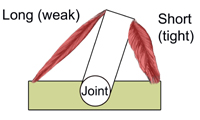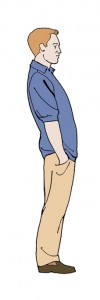 Muscle imbalance is the cause of so much of our pain and discomfort. I take the approach that most people are essentially splayed open in the front of the body and chronically tight and short in the back of the body. This causes untold difficulties throughout but the subject of today’s discussion is the lower back. What happens when you have low back pain due to chronically tight lower back muscles and are told the “Build the core”, or do “Ab work” to fix the problem.
Muscle imbalance is the cause of so much of our pain and discomfort. I take the approach that most people are essentially splayed open in the front of the body and chronically tight and short in the back of the body. This causes untold difficulties throughout but the subject of today’s discussion is the lower back. What happens when you have low back pain due to chronically tight lower back muscles and are told the “Build the core”, or do “Ab work” to fix the problem.
We’ll start with a recap of good posture. We think that good posture aligns the bones so that they can hold the body up instead of the usual environment that asks muscles and ligaments to hold us up. Muscles are movers; very few of them are involved in holding us upright. If we stand with good posture the muscles on the front of the body are equal in length and tone to the muscles on the back of the body.
Unfortunately this is rarely the case. We think everyone leans backwards when standing and walking, leading to habitually tight muscles in the lower back. This leaning backwards puts undue pressure on the spinal column— it forces the upper body backwards, the head forward, and most importantly for this discussion habitually shortens the muscles of the lower back. These include quadratus lumborum, the multifidus, and the erector spinea. The mulitifidus and erector spinea run up the length of the spine but they require tone at their base in order to have tone from top to bottom. It is hard to have tone in the low back muscles if you are leaning backwards and compressing them all the time.
Building the core is a common and correct prescription for low back pain; once in pain it is hard to be truly free of back pain without developing a strong core. And while core work is necessary it is key to realize that if you are working to shorten the front of the body you have to give equal effort to lengthening the back. Imagine what could happen if the lower back stays short and tight, the whole trunk can become compressed and even impacted.
We need to combine lengthening the back with shortening the front. I think it is much easier to shorten the front muscles then it is to lengthen the habitually messed up low back. These muscles can literally take years to release after a lifetime of dysfunction.
Building the body is a science that takes a very conscious approach to making changes. Don’t trust anyone but yourself when it comes to making these decisions. The balance of the lower belly and the lower back is a key to having good posture, good movement patterns and no low back pain.

